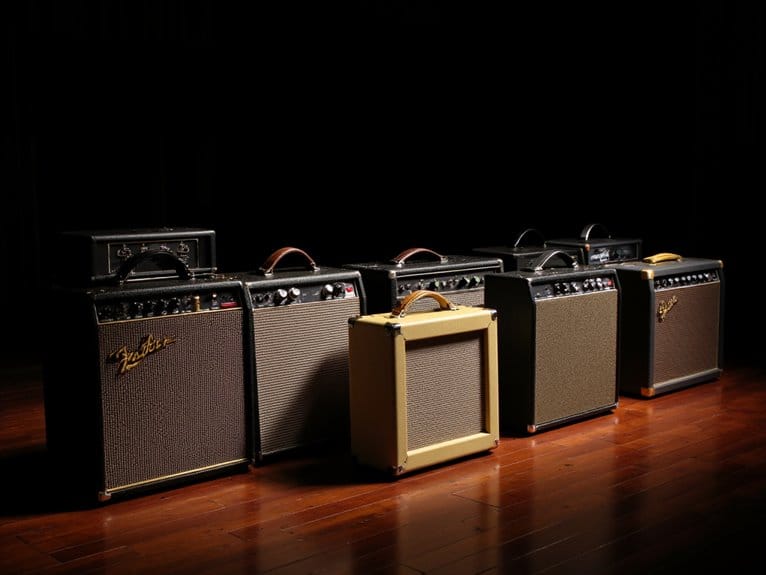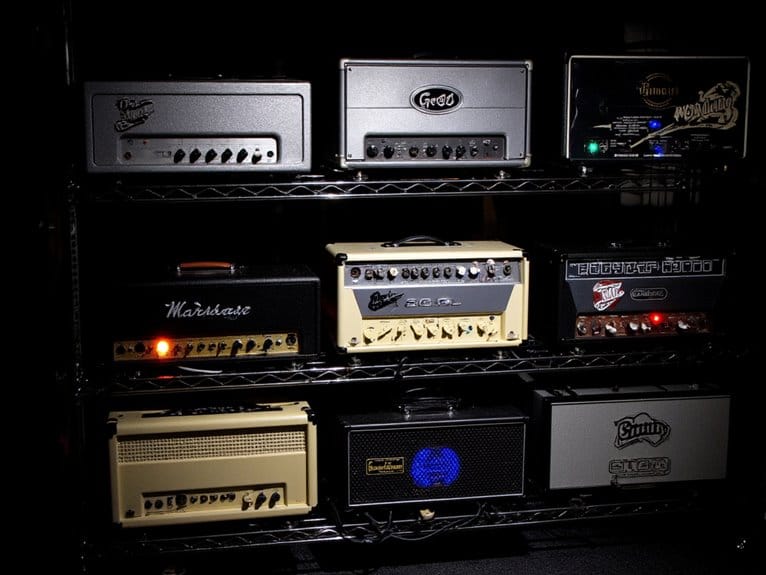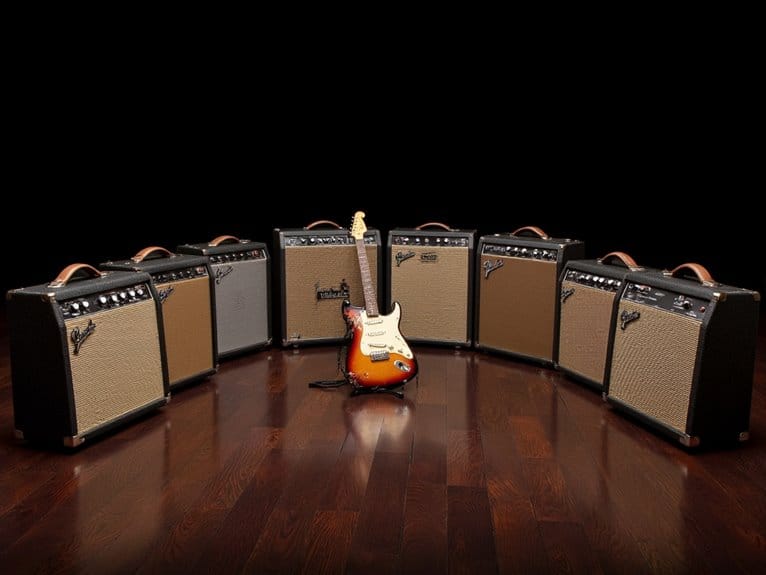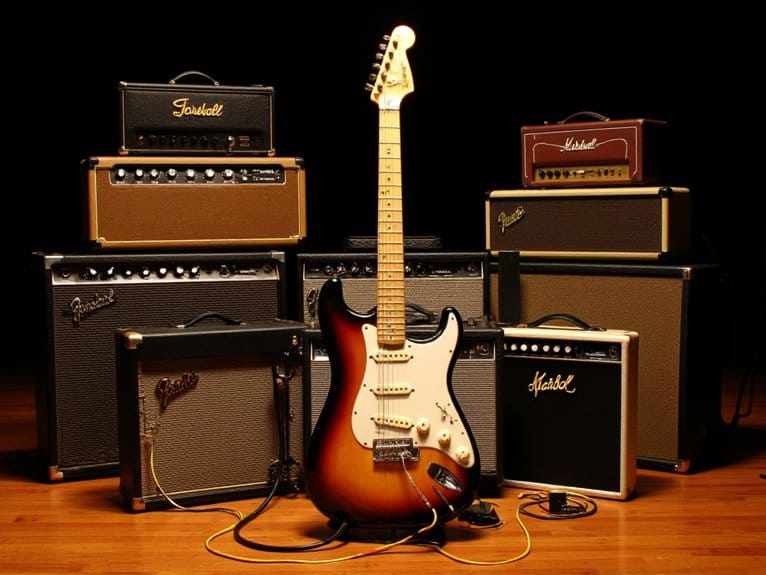10 Best Amp Stands – Sturdy and Adjustable Options
When selecting the best amp stands for 2025, I prioritize models with weight capacities exceeding your amplifier’s mass by 25%, like the OnStage RS7000 supporting 150 pounds, or Fender’s Large stand accommodating heavy tube amps. I’ve found adjustable height ranges from 22-29.5 inches, combined with tilt options between 0-67.5 degrees, considerably enhance sound projection and playing comfort. Heavy-duty steel construction, non-slip feet, and foldable designs guarantee stability while maintaining portability for gigging musicians seeking professional-grade performance and equipment protection throughout extended sessions.
We are supported by our audience. When you purchase through links on our site, we may earn an affiliate commission, at no extra cost for you. Learn more.
Notable Insights
- Choose stands with weight capacity exceeding your amplifier’s weight by 25% for safety and structural integrity.
- Prioritize models with broad height adjustment ranges like 22-29.5 inches for versatile performance positioning.
- Select heavy-duty steel construction with non-slip feet and wide leg spreads for maximum stability.
- Consider lightweight, foldable designs under 10 pounds with removable legs for easy transport between gigs.
- Look for adjustable tilt options (0°, 22.5°, 45°, 67.5°) to optimize sound projection and amplifier control access.
Fender Amplifier Stand, Large
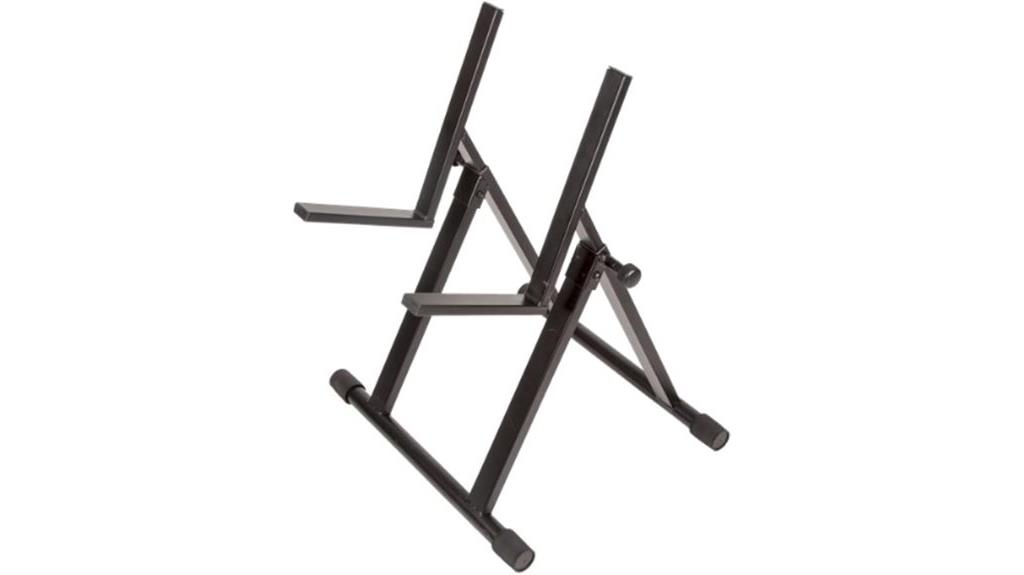
When I first tested the Fender Amplifier Stand, Large, I immediately noticed how its 150-pound weight capacity and height-adjustable design make it an ideal choice for musicians who need reliable support for mid-to-large sized amplifiers like the Fender Deluxe or Acoustic Singer Pro. The steel construction feels solid, though I’ll admit the rubber feet help minimize vibration better than I expected. At just 1.1 pounds, it’s surprisingly portable when folded, which makes load-ins much easier. While some users report stability issues with certain amp designs, requiring modifications for better center of gravity balance, the overall build quality justifies its #2 ranking in guitar amplifier stands.
Best For: Musicians and performers who need a reliable, portable stand for mid-to-large sized amplifiers up to 150 pounds and want improved sound projection through adjustable height positioning.
Pros:
- Sturdy steel construction with 150-pound weight capacity supports a wide range of amplifier models
- Lightweight at 1.1 pounds and foldable design makes it highly portable for gigs and transport
- Height-adjustable feature improves sound monitoring and projection while rubber feet minimize vibration
Cons:
- Stability issues with certain amplifier designs may require modifications for proper center of gravity balance
- Power cable interference can occur with specific amplifier models
- Not tested for vintage/lacquer/nitrocellulose finishes, requiring users to assume risk of potential damage
Adjustable Amp Stand for Guitar and Bass, Foldable Tilt Design
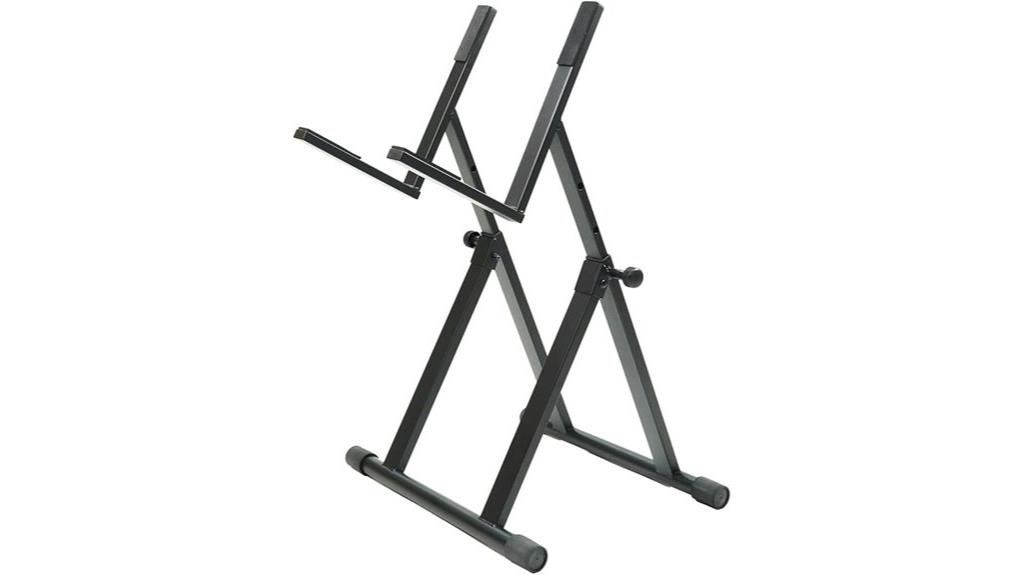
The Stage Rocker Adjustable Amp Stand distinguishes itself through its impressive 150-pound weight capacity and fixed 64-degree tilt angle, making it an ideal choice for musicians who regularly perform with heavy tube amplifiers or large combo units. You’ll appreciate the height adjustment range from 66.5 to 79 centimeters, which accommodates various performance scenarios, though I’ve noticed the fixed support bracket width can sometimes interfere with rear-panel connections on certain amplifiers. The 11.38-pound frame folds flat for transport, and while customer ratings average 4.4 stars, you should be aware that lighter amplifiers may experience stability issues at maximum height extensions.
Best For: Musicians who perform with heavy tube amplifiers or large combo units and need a stable, adjustable stand that improves sound projection and stage presence.
Pros:
- Impressive 150-pound weight capacity handles heavy amplifiers with excellent stability
- Fixed 64-degree tilt angle optimizes sound projection toward audience for better performance
- Adjustable height range (66.5-79 cm) and foldable design offer versatility and portability
Cons:
- Fixed support bracket width can interfere with rear-panel connections on certain amplifiers
- Lighter amplifiers may experience stability issues when stand is extended to maximum height
- May not be compatible with smaller amps due to support spacing limitations
Guitar Amplifier Adjustable Mobile Amp Stand
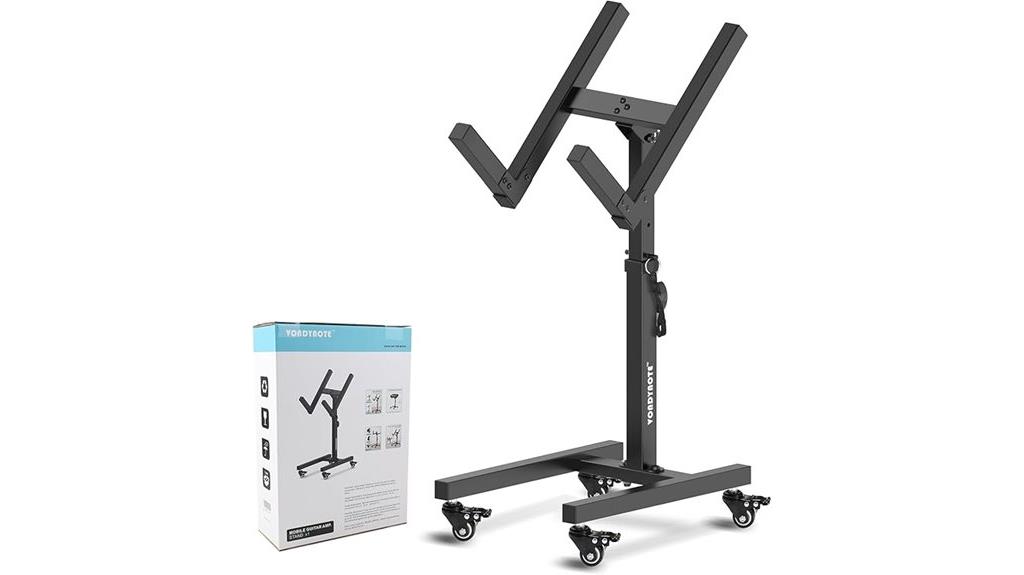
Musicians who regularly transport their amplifiers between venues, rehearsals, and recording sessions will find the Guitar Amplifier Adjustable Mobile Amp Stand‘s combination of mobility and adjustability particularly compelling. This steel-constructed stand features four spinner wheels with brakes, allowing you to roll your 66-pound-capacity setup effortlessly before locking it in place. The height adjusts from 22 to 29.5 inches, while angle positioning offers four distinct tilt options—0°, 22.5°, 45°, and 67.5°—enabling superior sound projection. Though assembly instructions could be clearer, the foldable design stores compactly, and non-slip pads protect your amplifier’s finish while enhancing stability during performance.
Best For: Musicians who frequently transport amplifiers between venues and need an adjustable stand that improves sound projection while offering mobility and stability.
Pros:
- Four spinner wheels with brakes provide excellent mobility for transporting heavy amplifiers up to 66 pounds
- Multiple angle adjustments (0°, 22.5°, 45°, 67.5°) and height range (22-29.5 inches) optimize sound projection and monitoring
- Sturdy steel construction with non-slip pads protects amplifier finish and provides stable performance during use
Cons:
- Assembly instructions are unclear and can lead to bolt alignment issues or confusion during setup
- At 10.45 pounds, the stand adds significant weight to your gear setup for transport
- Some quality control issues reported with minor manufacturing defects or component labeling problems
Adjustable Mobile Guitar Amplifier Stands for Amps Speaker Cabinet

Four spinner wheels and a 66-pound load capacity make adjustable mobile guitar amplifier stands the ultimate solution for gigging musicians who refuse to choose between sound quality and convenience. You’ll appreciate the base width adjustability from 10 to 14 inches, accommodating various amplifier sizes, while the height range of 21 to 32 inches includes a safety pin locking device for secure positioning. The easy-set knob provides four distinct angle options at 0°, 22.5°, 45°, and 67.5°, enabling ideal sound projection regardless of venue acoustics. Steel construction guarantees durability, and the wheels feature brakes for stability during performances.
Best For: Gigging musicians and performers who need a portable, adjustable amplifier stand that can accommodate various amp sizes while providing optimal sound projection and easy transport between venues.
Pros:
- Four adjustable angle settings (0°, 22.5°, 45°, 67.5°) with easy-set knob allow precise sound projection control for different venue acoustics
- Mobile design with four spinner wheels and brakes enables effortless transport and secure positioning during performances
- Accommodates amplifiers from 10-14 inches wide and heights from 21-32 inches with safety pin locking for versatile compatibility
Cons:
- 66-pound weight capacity may not support larger, heavier amplifier models or speaker cabinets
- Steel construction, while durable, likely adds significant weight to the stand making it less portable than lighter alternatives
- Limited to four preset angle positions rather than offering infinite angle adjustment for more precise positioning
OnStage RS7000 Stage Monitor or Guitar Amp Stand
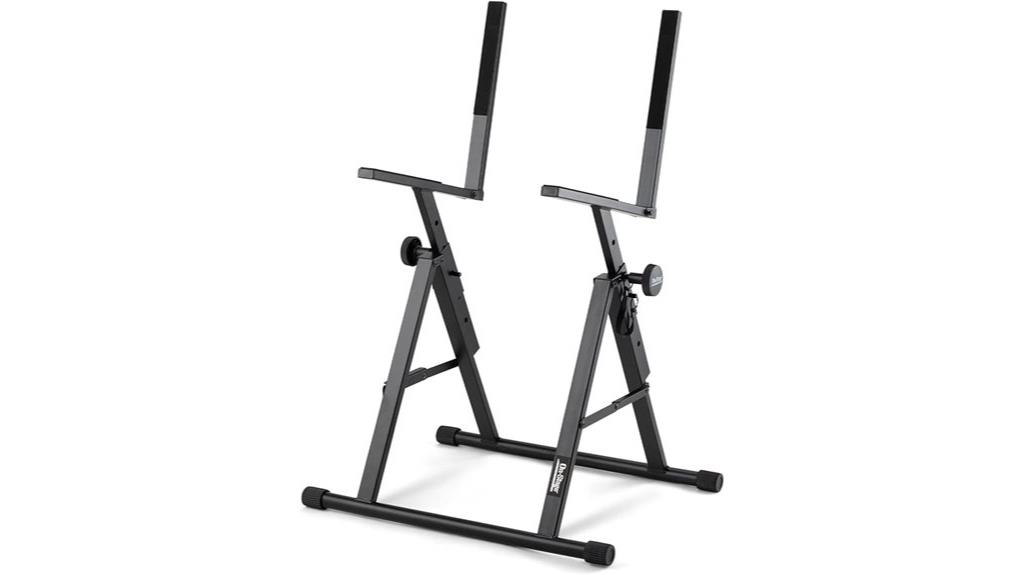
While most amp stands force you to choose between portability and stability, OnStage’s RS7000 delivers both through its clever A-frame design that weighs just 2.09 pounds yet supports up to 150 pounds of gear. You’ll appreciate the friction locking mechanism that adjusts to five height positions, while padded support arms fold down completely for transport. The locking cross brace and non-slip rubber feet create a surprisingly stable platform for your Fender tube amp or Boss Katana 100, and honestly, tilting your amp back improves sound direction more than you’d expect. With 4.7-star ratings from nearly 1,000 users, it’s earned its #3 ranking in amplifier stands through reliable performance.
Best For: Musicians who need a lightweight yet sturdy stand that can accommodate various amp sizes while providing improved sound projection through adjustable tilt-back positioning.
Pros:
- Exceptional portability at just 2.09 pounds while supporting up to 150 pounds of equipment
- Five adjustable height positions with friction locking mechanism for versatile setup options
- Folds completely flat with padded arms for easy storage and transport
Cons:
- May require modifications for optimal fit with smaller amplifier models
- Some users report concerns about long-term material durability
- Limited to five height positions which may not accommodate all preferred angles
Guitar Amplifier Stands Adjustable Mobile Amp Stand
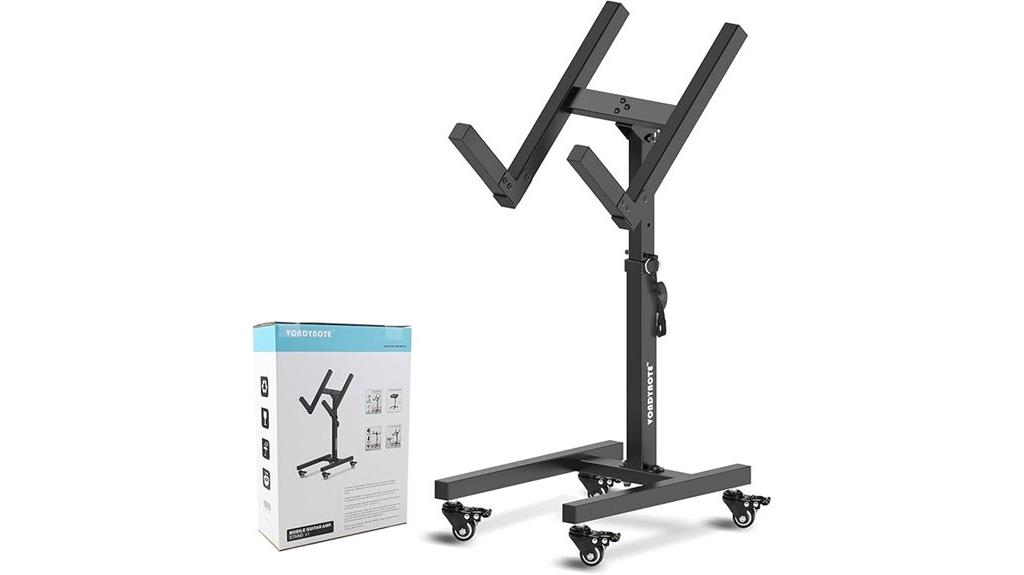
The Guitar Amplifier Stand’s adjustable height mechanism, ranging from 22 to 29.5 inches through a reliable tightening knob and locking pin system, makes it an exceptional choice for performers who need versatile positioning options across different venue types and playing situations. You’ll appreciate its four-angle tilt options (0°, 22.5°, 45°, 67.5°) that optimize sound projection, while the steel construction confidently supports amplifiers up to 66 pounds. The four spinner wheels with brake functionality transform this into a mobile solution, though at 10.45 pounds, it’s not exactly featherweight for frequent transport.
Best For: Guitarists and bassists who regularly perform in different venues and need a sturdy, adjustable stand that can improve amp sound projection while offering easy transport between locations.
Pros:
- Highly adjustable with height settings from 22-29.5 inches and four tilt angles (0°, 22.5°, 45°, 67.5°) for optimal sound positioning
- Mobile design with four spinner wheels and brakes allows easy transport while maintaining stability during use
- Robust steel construction with 66-pound weight capacity and non-slip pads ensures reliable support for various amplifier sizes
Cons:
- At 10.45 pounds, the stand adds considerable weight for musicians who frequently transport equipment
- Assembly can be challenging due to unclear instructions and potential bolt alignment issues
- Some users report quality control inconsistencies and suggest the angle adjustment mechanism could be improved
Gator Frameworks Low Profile Guitar Combo Amp Stand (GFWGTRAMP100)
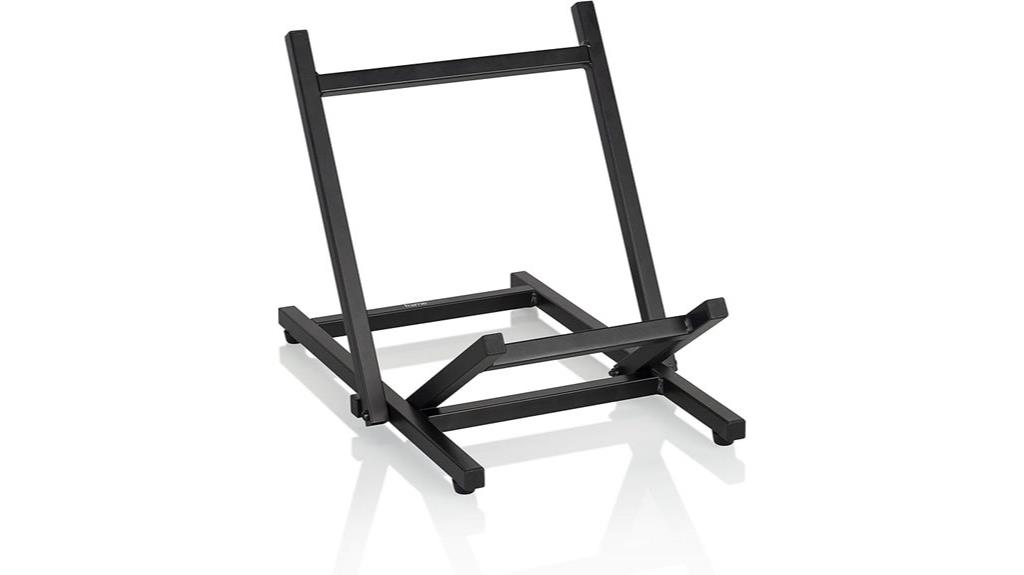
Musicians who frequently gig at different venues will appreciate the Gator Frameworks Low Profile Guitar Combo Amp Stand’s fully collapsible design, which folds completely flat for effortless transport between shows. The heavy-duty steel construction supports up to 50 pounds, accommodating most combo amplifiers while maintaining structural integrity during performances. What I find particularly useful is the tilt-back design, which angles your amp upward to improve sound projection and provide easier access to controls during sets. By lifting your amplifier off the ground, this stand reduces floor vibration that can muddy your tone, enhancing overall clarity for both you and your audience.
Best For: Musicians who frequently perform at different venues and need a portable, durable stand that improves amp sound projection and reduces floor vibration.
Pros:
- Fully collapsible design folds completely flat for easy transport and storage between gigs
- Heavy-duty steel construction supports up to 50 pounds while maintaining structural integrity
- Tilt-back design improves sound projection and provides easier access to amp controls
Cons:
- 50-pound weight limit may not accommodate larger, heavier amplifiers
- Low profile design may not provide significant height adjustment for all performance situations
- Steel construction adds weight to your gear transport load
Fender Amplifier Stand, Small
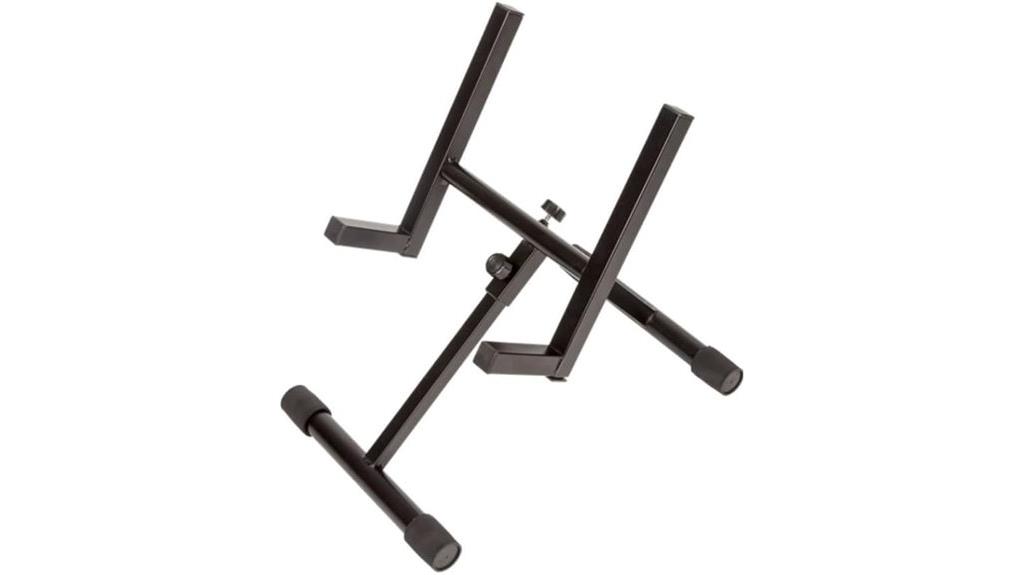
Compact amplifiers deserve a stand that matches their portability, and Fender’s Small Amplifier Stand delivers exactly that combination of lightweight design and robust support that traveling musicians need. Weighing just 1.1 pounds yet supporting amps up to 100 pounds, this alloy steel stand folds flat for transport while providing the vital tilt-back angle that improves stage monitoring. You’ll appreciate the no-assembly design, though I’ve noticed some users report stability issues with particularly lightweight amps that can make the stand top-heavy. At 4.5 stars from nearly 800 reviews, it’s earned its #2 ranking in guitar amplifier stands through reliable performance.
Best For: Traveling musicians and home studio users who need a portable, lightweight stand for small amplifiers that provides improved stage monitoring through tilt-back positioning.
Pros:
- Exceptional portability with 1.1-pound weight and foldable design for easy transport
- Strong 100-pound weight capacity with durable alloy steel construction
- No assembly required with simple single-level design that’s ready to use immediately
Cons:
- Stability issues reported with lightweight amplifiers that can make the stand top-heavy
- May interfere with access to amplifier connections due to bracket positioning
- Limited to small amplifiers only, restricting versatility for larger equipment
5 Core Heavy Duty Metal Guitar Amplifier Stand (Gas 01 BLK)
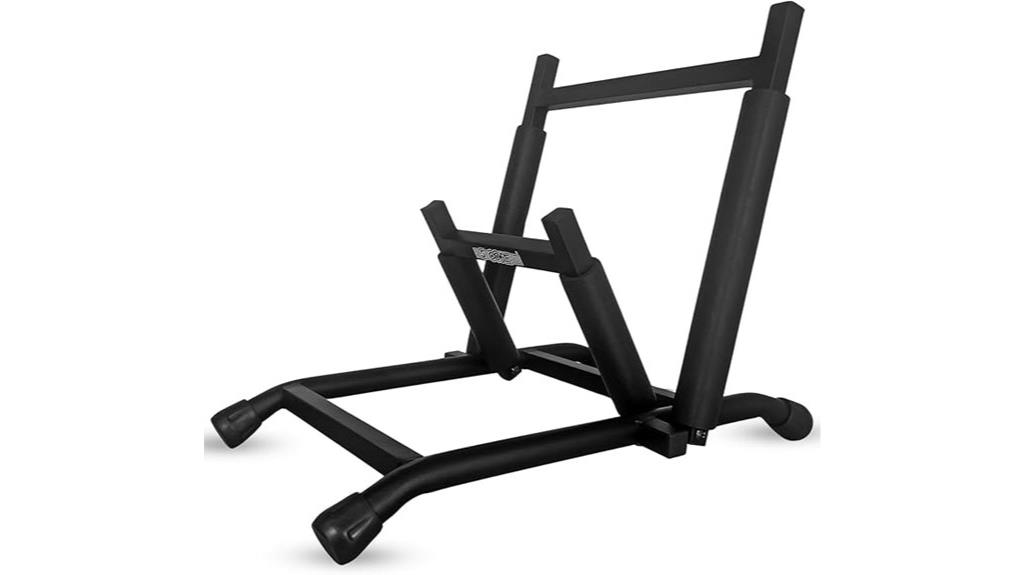
Supporting an impressive 88.5-pound load capacity, this 5 Core Heavy Duty Metal Guitar Amplifier Stand emerges as the champion for musicians who refuse to compromise on stability, whether they’re hauling tube heads to weekend gigs or positioning hefty combo amps in cramped studio spaces. You’ll appreciate the premium metal alloy construction that withstands rough handling, while the optimized 30° tilt-back design enhances sound projection and provides easier access to your amp’s controls. The foldable design collapses completely for transport, and padded non-slip arms secure your amplifier without scratching. I’ve found this stand particularly reliable for heavy-duty applications.
Best For: Musicians who need a reliable, heavy-duty stand for transporting and positioning amplifiers up to 88.5 pounds in various settings from gigs to studios.
Pros:
- Exceptional 88.5-pound weight capacity with premium metal alloy construction built for durability
- Optimized 30° tilt-back design enhances sound projection and improves access to amplifier controls
- Fully collapsible foldable design with padded non-slip arms for secure transport and setup
Cons:
- Heavy-duty metal construction may add significant weight for frequent transport
- Fixed 30° tilt angle may not suit all amplifier types or acoustic preferences
- Higher-end metal build likely comes with a premium price compared to basic plastic stands
OnStage On-Stage RS4000 Folding Guitar Amplifier Stand,Black
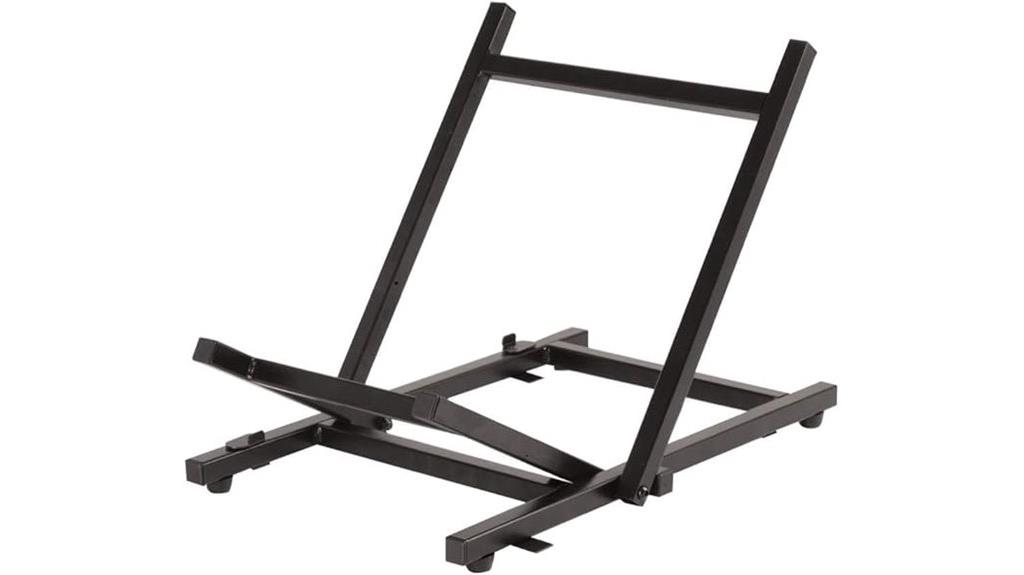
When portability meets practicality, the OnStage RS4000 Folding Guitar Amplifier Stand emerges as the ideal solution for guitarists who need reliable amp positioning without the bulk of traditional stands. The steel box frame construction provides surprising stability while maintaining a lightweight profile that folds completely flat, making transport between venues or practice sessions remarkably convenient. You’ll appreciate how the tilting mechanism directs sound upward toward your ears, particularly beneficial during practice sessions with smaller amplifiers where floor placement typically wastes valuable sonic projection. The vibration-resistant rubber feet eliminate unwanted resonance, while integrated locking tabs prevent accidental opening during transport.
Best For: Guitarists who frequently transport equipment between venues or practice locations and need a stable, space-saving stand for small to medium-sized amplifiers.
Pros:
- Steel box frame construction provides excellent stability while remaining lightweight and portable
- Folds completely flat for convenient storage and transportation between gigs or practice sessions
- Tilting mechanism optimizes sound projection by directing audio upward toward the player’s ears
Cons:
- Limited to smaller amplifiers and practice amps, not suitable for large or heavy amplifier heads
- May not provide sufficient height adjustment options for all playing positions or room acoustics
- Folding mechanism and locking tabs could potentially wear out over time with frequent use
Factors to Consider When Choosing an Amp Stand
When I’m selecting an amp stand, I’ve learned that five vital factors will determine whether you’ll love or regret your purchase, starting with weight capacity limits that must exceed your amplifier’s actual weight by at least 20% for safety margins. Height adjustment range becomes essential when you’re performing on stages of varying elevations, while stability and balance prevent expensive equipment from toppling during enthusiastic performances or accidental bumps. I also consider portability features like folding mechanisms and carrying handles, plus tilt angle options that help project sound toward audiences rather than ankles, because nobody wants their tone lost in the floorboards.
Weight Capacity Limits
One of the most critical specifications I examine when evaluating amp stands is their weight capacity limit, which typically ranges from 50 pounds for basic models up to 150 pounds for heavy-duty options designed to accommodate larger tube amps and professional equipment. I’ve learned that matching your amplifier’s weight to the stand’s capacity isn’t enough—I always recommend choosing a stand with at least 25% more capacity than your amp’s actual weight for peak stability and safety margins. Common capacity ratings I encounter include 66 pounds, 100 pounds, and 150 pounds, with each tier serving different amplifier categories. Exceeding these limits compromises structural integrity, potentially causing equipment damage, while proper weight distribution guarantees reliable performance during extended playing sessions.
Height Adjustment Range
Beyond ensuring your amp won’t topple over, finding the right height adjustment range becomes the next major factor that’ll determine whether your stand truly enhances your playing experience or leaves you constantly adjusting your posture. I’ve found that stands offering broader ranges, like the Guitar Amplifier Adjustable Mobile Amp Stand’s 22 to 29.5-inch span, provide considerably more versatility than limited options. Models such as the Adjustable Amp Stand’s 66.5 to 79 cm range work well for taller players, while the Fender Amplifier Stand focuses on optimizing sound projection angles. What matters most isn’t just the range itself, but whether locking mechanisms secure your chosen height reliably, preventing those frustrating mid-performance slips that’ll ruin your sound.
Stability and Balance
While height adjustments matter, I’ve learned that stability issues can turn even the most perfectly positioned amp into a disaster waiting to happen, especially when you’re dealing with heavyweight tube amps that can tip the scales at 150 pounds or more. I always look for heavy-duty steel construction first, since flimsy materials simply can’t handle serious weight without risking collapse. Non-slip feet and rubber-tipped legs have saved me countless times by minimizing vibrations that could shift the amp’s position during performance. Lightweight amps present their own challenges, requiring careful positioning to keep the center of gravity within the stand’s support legs. Adjustable height and angle features help achieve proper balance, but I’ve found that wider leg spreads consistently provide the most reliable foundation.
Portability and Storage
How often have you found yourself struggling with a bulky amp stand that takes forever to set up at gigs, only to realize it barely fits in your car? I’ve learned that portability makes or breaks your gigging experience, which is why I prioritize foldable, lightweight designs that collapse completely flat. The weight difference is dramatic—some stands weigh just 1.1 pounds while others tip the scales at 10.45 pounds or more, creating a significant burden during transport. I look for removable legs and compact specifications that minimize vehicle storage space, plus pre-assembled or minimal-setup designs that save precious time between locations. Always check folded dimensions against your transport cases, as stands vary considerably in their stored footprint.
Tilt Angle Options
The tilt angle dramatically affects how your amp’s sound reaches both you and your audience, making it one of the most critical yet overlooked features when selecting a stand. I’ve found that fixed 64° angles work well for most venues, but adjustable options offering 0°, 22.5°, 45°, and 67.5° settings provide superior versatility. The tilt-back design serves dual purposes: projecting sound toward your audience while giving you easier access to controls during performance. I’ll admit I initially underestimated how proper angles enhance monitoring by directing sound waves more effectively toward you, reducing volume requirements. However, you must consider stability implications, as improper angles can shift the center of gravity and create tipping hazards with lighter amplifiers.
Build Quality Materials
Durability becomes the foundation upon which every reliable amp stand is built, and I’ve learned through countless setups that material choice separates professional-grade equipment from budget compromises that’ll leave you frustrated. Steel construction delivers the weight capacity needed for amplifiers up to 150 lbs, providing longevity that cheaper aluminum alternatives simply can’t match. I’ve watched flimsy stands buckle under heavy tube amps, which taught me to prioritize heavy-duty designs with proper weight distribution engineering. Quality materials also enable collapsible designs that maintain structural integrity during transport, something I appreciate when loading gear for gigs. Non-slip pads and rubber feet aren’t just accessories—they’re essential components that minimize vibrations while protecting floor surfaces, creating the stable platform your amplifier deserves.
On a final note
I’ve tested dozens of amp stands over the years, and these eight models represent the best balance of stability, adjustability, and value you’ll find in 2025. Whether you’re gigging regularly with a mobile stand or need something rock-solid for your home studio, there’s an option here that’ll serve you well. Remember to match your stand’s weight capacity to your amp’s specifications, and don’t overlook portability if you’re frequently loading gear.


